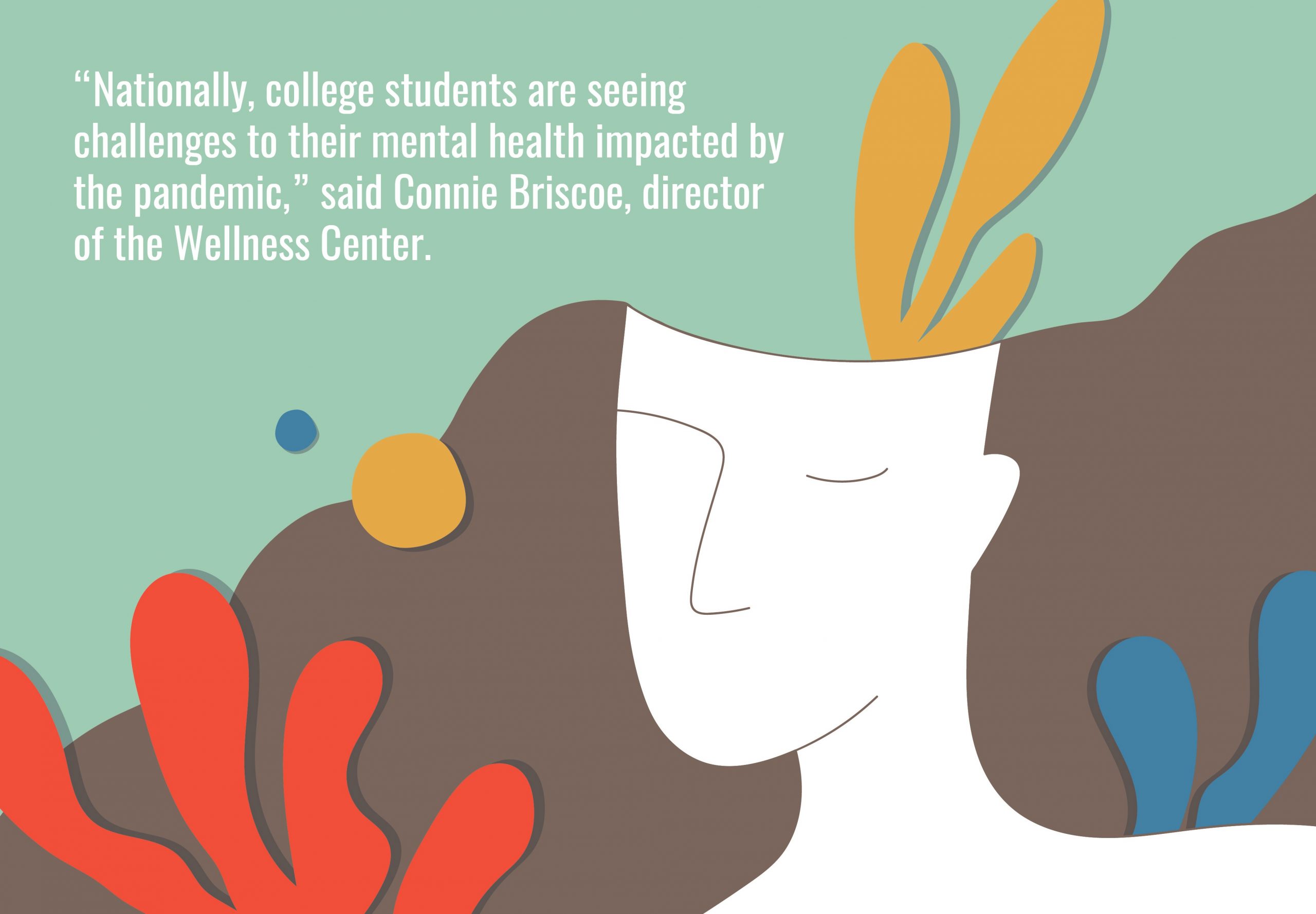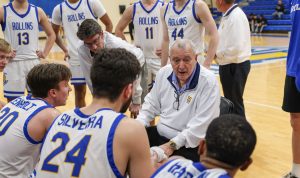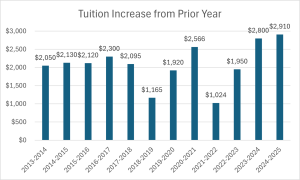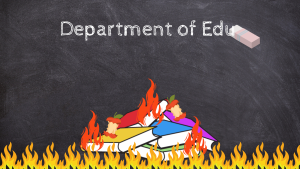As student mental health increases in vulnerability this semester, the Wellness Center has implemented a new online request option and updated its treatment plans in the wake of the pandemic. Most appointments are now conducted through telehealth.
What does Rollins data look like?
Current CAPS data, while early, reveals increases in reports of anxiety and depression. Right now, 63 percent of CAPS students indicated experiencing anxiety, and 33 percent indicated experiencing depression.
These numbers are lower compared to last year’s at this time, in which 77 percent of CAPS students reported increased anxiety and 40 percent reported depression.
However, Director of Wellness Connie Briscoe said that it is difficult to derive meaning from data comparisons since they do not follow the same timeline.
“These numbers are deceptive,” said Briscoe. “Current data, when comparing to last year’s data, does not mean as much since the school year started two weeks late.”
In either case, Briscoe said that “we’re experiencing more variety in student mental health.” She pointed out that the pandemic affects students in dramatically different ways.
Allison van Tilborgh (’21) shares the sentiment that mental health is diverse now more than ever: “My mental health is fluid, especially now, and I can now say that there aren’t as many specific things that make it worse—it’s more situational, day-by-day.”
What do national trends look like?
Student mental health has been a focus of many national studies the last few months, with goals to better understand the effects of COVID-19 on college campuses.
The results of these studies reveal the undeniability of the effects of COVID-19 on young people.
According to research from the Centers for Disease Control and Prevention (CDC), one in four people aged 18 to 24 seriously contemplated suicide in June.
In another study by researchers at Texas A&M University, 71 percent of surveyed students indicated increased stress and anxiety due to COVID-19. In addition, 90 percent of students reported worrying about their own health and of their loved ones, 89 percent reported having difficulty concentrating, and 82 percent reported increased concerns of academic performance.
“Nationally, college students are seeing challenges to their mental health impacted by the pandemic,” said Briscoe. “Trends such as increases in suicide ideation, anxiety, concentration, sleep, and isolation are all increasing concerns … Rollins is no different.”
Quarantine and isolation play a large part in students’ emotional wellbeing.
“Students can be quite resilient and successfully adjust to wearing a mask, sacrificing large parties, and maintaining physical distance,” said Stacey Dunn, professor and licensed clinical psychologist. “But lots of students feel increasingly isolated and any pre-existing depression or anxiety has worsened.”
Virtual modes of socialization and learning can also complicate mental health. For instance, van Tilborgh works 30 hours a week and noticed increased distractions and a lack of separation between her school and work lives:
“What this [virtual] environment does for me is it makes it harder to turn off. Before, school was a place I could show up to, and the rest of the world melted away. My family couldn’t reach me, my work couldn’t reach me, my technology was off. But my work world and my school world are merging together; they are literally a click away on my computer screen,” van Tilborgh said.
New procedures and support for out-of-state students
While the Wellness Center is providing most care online, if a student is facing a crisis, “we let students come in in-person, socially distanced … if they need need face-to-face support,” said Briscoe.
The Wellness Center is only licensed to practice in Florida, so counselors cannot legally provide ongoing therapy to out-of-state students. The Wellness Center team, therefore, had to come up with a dynamic plan.
“We were able to hire a clinical case manager who works with out-of-state students to locate resources in their area,” said Briscoe. “We are also planning to significantly increase online workshops to out-of-state students since it is not considered clinical help.”
The team has also developed YouTube and Instagram pages for all students, but out-of-state students are especially encouraged to take advantage of their resources. Briscoe said that the center is emphasizing “self-directed, self-management work” during this time.
Briscoe contributes the center’s ability to connect with out-of-state students to last spring’s trials and errors.
“It felt like such a gap without the clinical case manager,” Briscoe said. “The case manager can educate students about insurance, follow-ups, and examine barriers. It’s meeting a need we had for a long time, and the pandemic let us see that clearly.”
The case manager was hired via the Substance Abuse and Mental Health Services Administration (SAMHSA) grant issued to the center in November 2018.
Adapting to budget cuts
In addition to facing challenges related to care for out-of-state students, the Wellness Center also had to consider budget cuts, which were implemented due to COVID-19. The center had to let go an assistant director of CAPS, who was also a counselor.
Briscoe said, “Each counselor has administrative responsibilities, so since our counselor was cut, I’ve had to take on those responsibilities, and so have full-time staff in addition to their normal areas of responsibility and clinical loads. We have such a strong team … which has allowed us to make those adjustments.”
Adaptability also meant introducing an online request option. Originally, every student had to set up CAPS appointments via calling the front desk, but “we recognized that students do not like to use the phone. We didn’t want that to be a barrier to seeking help,” said Briscoe.
Students can now make CAPS appointments on the Wellness Center website, where students can leave their information on an online form. The front desk then calls back and establishes an appointment within 24 business hours.
While many aspects of Wellness Center procedures have changed, the step-care model, which provides individual plans for students, will remain.
CAPS adopted the step-care model last year, which led to a 20 percent increase in students who engaged with CAPS compared to the previous year.
Preventative measures and expert advice
According to Dunn, the warning signs of declining mental health include “avoiding friends entirely instead of accepting invitations to connect safely, escaping through drugs, alcohol, food, or binge watching Netflix, putting off assignments or missing class, struggling even to respond to texts/emails/phone calls, and not maintaining basic hygiene.”
Briscoe also said that one of the biggest signs of grief is numbness. “We do as much as we can to avoid or numb out—online shopping, sleeping, alcoholism,” she said. “These are things to look out for.”
Briscoe and Dunn hope that students make time to care for their mental health, especially during this time.
“I hope that students treat themselves with kindness and compassion, that they prioritize their self-care like sleep and diet, and that they are getting physical exercise and connecting with nature,” said Briscoe.
However, protecting student mental health also extends to faculty. When asked what faculty can do to support students throughout the pandemic, Dunn said that “holding students accountable while also being flexible and understanding will provide students fertile ground in which to grow through this pandemic.”
Briscoe echoed a similar sentiment of compassion and communication: “I am sure that every person on our campus is struggling right now; we all have our own stories of struggle. We need to share our stories and ask others to tell their stories. I want people to know that what they’re experiencing is real—the grief and the trauma—you should face it and feel it. We’re going to come out the other side.”















[…] especially acute issue was providing mental health care to students who were exposed to or infected with the virus, as well as students who were […]
[…] previously reported by The Sandspur, the Wellness Center adapted its old strategies last year and created new ones in […]
[…] and Garnier said the Wellness Center was subject to a 15 percent budget cut in 2020 due to COVID-19. As a result, the position of Assistant Director of CAPS was removed in […]